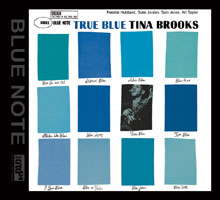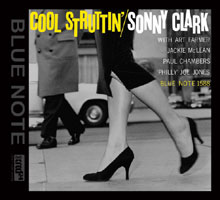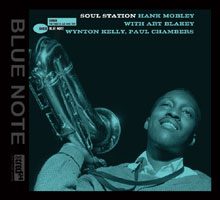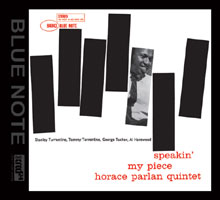Tina Brooks • True Blue
Sonny Clark • Cool Struttin'
Hank Mobley • Soul Station
Horace Parlan • Speakin' My Piece
hen all of this music was recorded a half-century ago, no one, including Alfred Lion and Francis Wolff, the principals of Blue Note Records, could have anticipated the array of formats in which it would be available so many years later. The most purist and esoteric are the 45rpm LPs from Music Matters and these XRCD24 CDs from Audio Wave, which is the music-production division of mail-order music and equipment seller Elusive Disc. What is an XRCD24? Not so much a CD on steroids as one that's been created with exacting care -- and a suite of the best JVC digital electronics -- from beginning to end. The analog master tape is converted to digital with a 24-bit JVC K2 analog-to-digital converter to produce a 24-bit master. The 24-bit digital data then pass through JVC’s Digital K2 to regenerate pure 24-bit digital data. These are stored on a magneto-optical disk and then converted to 16 bits with JVC K2 Super Coding. A high-precision JVC DVD K2 Laser cuts a Red Book-format glass master using JVC’s Extended Pit Cutting Technology, which produces more precise pit lengths. JVC eliminates two traditional production steps by using its Master Stamper Process to create the XRCD24 stamper directly from the glass master. This allows only a limited number of XRCD24s to be produced from each stamper. The human process mirrors the rigor of the mechanical process. Mastering engineer Alan Yoshida oversaw the analog-to-digital conversion. Renowned for his painstaking process of preparing and aligning the analog master tape for playback, he has mastered hundreds of XRCDs, and his sonic results speak for themselves. Joe Harley and Bob Bantz, producer and executive producer, provided insight and guidance in the mastering suite, helping to achieve the keen sonic balance these CDs display. Why have they chosen XRCD24 instead of SACD or high-resolution download? Because they believe it provides the best overall digital sound and "the highest-quality transfer from the original master tape to Red Book-standard CD." Whether we like it or not, CD remains the chosen digital format of discriminating listeners -- the people who will be buying these CDs. Widely considered the most important and influential jazz label of all time, Blue Note Records produced hundreds of recordings during its busiest decades -- the 1950s and 1960s. These four sets represent not only some of the most historic music the label captured but also the work of a wide array of Blue Note's top-rank artists. Saxophonist Hank Mobley and pianists Sonny Clark and Horace Parlan each led many sessions and played backup on many more, while saxophonist Tina Brooks' four recordings for Blue Note (only one of which was released during his lifetime) have achieved legendary status. Other Blue Note notables featured here include drummers Art Blakey and Art Taylor, pianist Wynton Kelly, and bassist Paul Chambers -- Blue Note royalty all. You either know this music or should know it, and you win with these CDs in either case. Just like the best of the reissued Blue Note LPs, these CDs achieve a sonic balance that is not only more appropriate to modern high-resolution audio equipment than that of the original LPs, but also leads to a more realistic, natural rendering of the music. Astute listeners know that the very first Blue Note CD issues are sonically superior to the more recent RVG remasters. Well, these XRCD24s absolutely crush them both, displaying high-frequency air, midrange presence, and bottom-end definition and weight missing on earlier CDs and many LPs as well. To appreciate the full extent of the sonic improvement, play one of these XRCD24s and then an RVG remastered CD. You will immediately have to adjust the volume downward, and after a second or two you'll realize that the music's dynamic contrasts were casualties of the added loudness. The RVG CDs are well known for their crisp, thin sound and rather chalky tone, and comparison to the XRCD24s only make these maladies more apparent. Bits may be bits, but RVG bits don't sound the same as XRCD24 bits -- or even close to them. The track listings on both are identical, including any previously unreleased or alternate takes. More surprising perhaps is the way in which these XRCD24s improve on the sound of earlier XRCD and XRCD2 discs. These are the first Blue Note releases in this format, so no apples-to-apples comparison is possible, but the newer XRCD24s adhere more closely to the easy resolution of analog playback, and their low-end grunt is improved as well. XRCD packaging has been robust but inconsistent over the years. The discs have always come in heavy, bound digipak-like cases, but the earliest of these had no tray for storage and later examples had liner notes in Japanese. Audio Wave's crisp, glossy packaging is by far the best. The liner notes comprise a small pamphlet of materials, including the original LP's back-cover notes, previously unpublished session photos, and a short discussion of the project from Bob Bantz that underscores his commitment to producing recordings of unsurpassed quality. And the integral storage tray doesn't require bending the disc to release it -- a minor but welcome touch. At $30 each, these are certainly expensive CDs, and their
existence will seem counterintuitive to some in these days of downloading digital content.
No matter -- these are easily the best-sounding Blue Note CDs ever made, and they rival
the best LPs. Twenty-five titles are initially planned. With notable exceptions from
Herbie Hancock, Stanley Turrentine and Dexter Gordon, most are digital equivalents of
Music Matters releases. This seems appropriate, given the unequaled sonic and musical
qualities of these LPs and CDs. |




